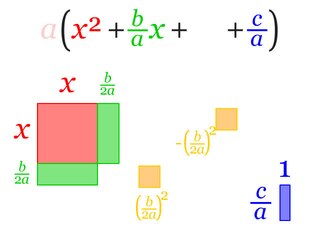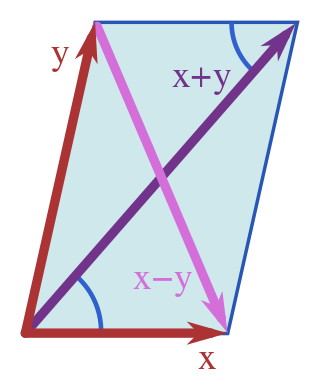In mathematics, Degen's eight-square identity establishes that the product of two numbers, each of which is a sum of eight squares, is itself the sum of eight squares. Namely:

First discovered by Carl Ferdinand Degen around 1818, the identity was independently rediscovered by John Thomas Graves (1843) and Arthur Cayley (1845). The latter two derived it while working on an extension of quaternions called octonions. In algebraic terms the identity means that the norm of product of two octonions equals the product of their norms:  . Similar statements are true for quaternions (Euler's four-square identity), complex numbers (the Brahmagupta–Fibonacci two-square identity) and real numbers. In 1898 Adolf Hurwitz proved that there is no similar bilinear identity for 16 squares (sedenions) or any other number of squares except for 1,2,4, and 8. However, in the 1960s, H. Zassenhaus, W. Eichhorn, and A. Pfister (independently) showed there can be a non-bilinear identity for 16 squares.
. Similar statements are true for quaternions (Euler's four-square identity), complex numbers (the Brahmagupta–Fibonacci two-square identity) and real numbers. In 1898 Adolf Hurwitz proved that there is no similar bilinear identity for 16 squares (sedenions) or any other number of squares except for 1,2,4, and 8. However, in the 1960s, H. Zassenhaus, W. Eichhorn, and A. Pfister (independently) showed there can be a non-bilinear identity for 16 squares.
Note that each quadrant reduces to a version of Euler's four-square identity:

and similarly for the other three quadrants.
Comment: The proof of the eight-square identity is by algebraic evaluation. The eight-square identity can be written in the form of a product of two inner products of 8-dimensional vectors, yielding again an inner product of 8-dimensional vectors: (a·a)(b·b) = (a×b)·(a×b). This defines the octonion multiplication rule a×b, which reflects Degen's 8-square identity and the mathematics of octonions.
By Pfister's theorem, a different sort of eight-square identity can be given where the  , introduced below, are non-bilinear and merely rational functions of the
, introduced below, are non-bilinear and merely rational functions of the  . Thus,
. Thus,

where,

and,

with,

Incidentally, the  obey the identity,
obey the identity,


In mathematics, the associative property is a property of some binary operations, which means that rearranging the parentheses in an expression will not change the result. In propositional logic, associativity is a valid rule of replacement for expressions in logical proofs.

The natural logarithm of a number is its logarithm to the base of the mathematical constant e, which is an irrational and transcendental number approximately equal to 2.718281828459. The natural logarithm of x is generally written as ln x, logex, or sometimes, if the base e is implicit, simply log x. Parentheses are sometimes added for clarity, giving ln(x), loge(x), or log(x). This is done particularly when the argument to the logarithm is not a single symbol, so as to prevent ambiguity.

In mathematics, the trigonometric functions are real functions which relate an angle of a right-angled triangle to ratios of two side lengths. They are widely used in all sciences that are related to geometry, such as navigation, solid mechanics, celestial mechanics, geodesy, and many others. They are among the simplest periodic functions, and as such are also widely used for studying periodic phenomena through Fourier analysis.

In mathematics, factorization (or factorisation, see English spelling differences) or factoring consists of writing a number or another mathematical object as a product of several factors, usually smaller or simpler objects of the same kind. For example, 3 × 5 is an integer factorization of 15, and (x – 2)(x + 2) is a polynomial factorization of x2 – 4.

In mathematics, the Lambert W function, also called the omega function or product logarithm, is a multivalued function, namely the branches of the converse relation of the function f(w) = wew, where w is any complex number and ew is the exponential function. The function is named after Johann Lambert, who considered a related problem in 1758. Building on Lambert's work, Leonhard Euler described the W function per se in 1783.

In mathematics, a quadratic polynomial is a polynomial of degree two in one or more variables. A quadratic function is the polynomial function defined by a quadratic polynomial. Before the 20th century, the distinction was unclear between a polynomial and its associated polynomial function; so "quadratic polynomial" and "quadratic function" were almost synonymous. This is still the case in many elementary courses, where both terms are often abbreviated as "quadratic".

In mathematics, a multiplicative inverse or reciprocal for a number x, denoted by 1/x or x−1, is a number which when multiplied by x yields the multiplicative identity, 1. The multiplicative inverse of a fraction a/b is b/a. For the multiplicative inverse of a real number, divide 1 by the number. For example, the reciprocal of 5 is one fifth (1/5 or 0.2), and the reciprocal of 0.25 is 1 divided by 0.25, or 4. The reciprocal function, the function f(x) that maps x to 1/x, is one of the simplest examples of a function which is its own inverse (an involution).
In algebra, the partial fraction decomposition or partial fraction expansion of a rational fraction is an operation that consists of expressing the fraction as a sum of a polynomial and one or several fractions with a simpler denominator.

In mathematics, a quartic equation is one which can be expressed as a quartic function equaling zero. The general form of a quartic equation is

In elementary algebra, completing the square is a technique for converting a quadratic polynomial of the form
In algebra, the Brahmagupta–Fibonacci identity expresses the product of two sums of two squares as a sum of two squares in two different ways. Hence the set of all sums of two squares is closed under multiplication. Specifically, the identity says
In mathematics, the matrix exponential is a matrix function on square matrices analogous to the ordinary exponential function. It is used to solve systems of linear differential equations. In the theory of Lie groups, the matrix exponential gives the exponential map between a matrix Lie algebra and the corresponding Lie group.
In complex analysis, a branch of mathematics, a generalized continued fraction is a generalization of regular continued fractions in canonical form, in which the partial numerators and partial denominators can assume arbitrary complex values.

In linear algebra, a branch of mathematics, the polarization identity is any one of a family of formulas that express the inner product of two vectors in terms of the norm of a normed vector space. If a norm arises from an inner product then the polarization identity can be used to express this inner product entirely in terms of the norm. The polarization identity shows that a norm can arise from at most one inner product; however, there exist norms that do not arise from any inner product.
In mathematics, the seven-dimensional cross product is a bilinear operation on vectors in seven-dimensional Euclidean space. It assigns to any two vectors a, b in a vector a × b also in . Like the cross product in three dimensions, the seven-dimensional product is anticommutative and a × b is orthogonal both to a and to b. Unlike in three dimensions, it does not satisfy the Jacobi identity, and while the three-dimensional cross product is unique up to a sign, there are many seven-dimensional cross products. The seven-dimensional cross product has the same relationship to the octonions as the three-dimensional product does to the quaternions.
In linear algebra, an augmented matrix is a matrix obtained by appending a -dimensional row vector , on the right, as a further column to a -dimensional matrix . This is usually done for the purpose of performing the same elementary row operations on the augmented matrix as is done on the original one when solving a system of linear equations by Gaussian elimination.

In mathematics, the lemniscate elliptic functions are elliptic functions related to the arc length of the lemniscate of Bernoulli. They were first studied by Giulio Fagnano in 1718 and later by Leonhard Euler and Carl Friedrich Gauss, among others.

In mathematics, the inverse hyperbolic functions are inverses of the hyperbolic functions, analogous to the inverse circular functions. There are six in common use: inverse hyperbolic sine, inverse hyperbolic cosine, inverse hyperbolic tangent, inverse hyperbolic cosecant, inverse hyperbolic secant, and inverse hyperbolic cotangent. They are commonly denoted by the symbols for the hyperbolic functions, prefixed with arc- or ar-.
In mathematics, the Hurwitz problem is the problem of finding multiplicative relations between quadratic forms which generalise those known to exist between sums of squares in certain numbers of variables.
In algebra, Pfister's sixteen-square identity is a non-bilinear identity of form






















